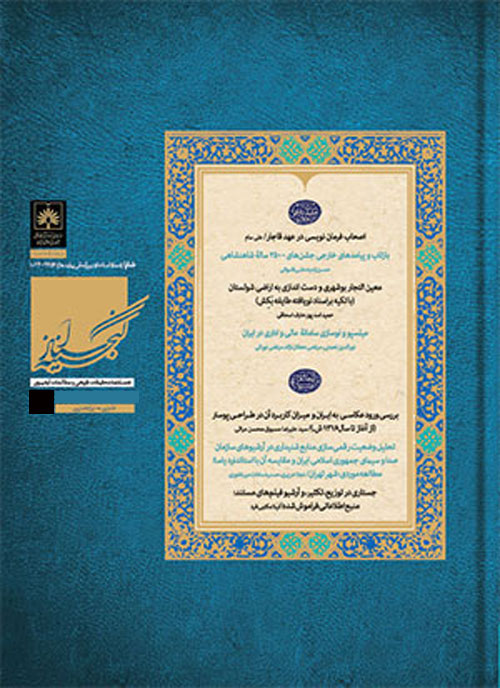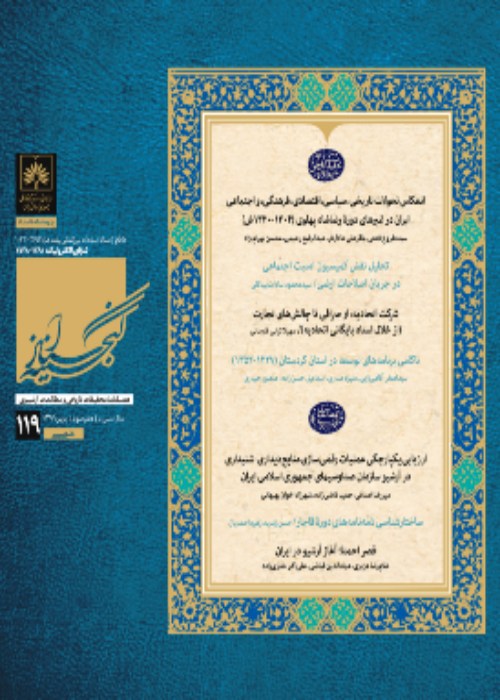فهرست مطالب

فصلنامه گنجینه اسناد
پیاپی 96 (زمستان 1393)
- تاریخ انتشار: 1393/12/01
- تعداد عناوین: 7
-
- تحقیقات تاریخی
-
صفحات 6-24هدفبعد ازسقوط حکومت محلی (امارت) اردلان ها، که از زمان زمان ناصر الدین شاه، حکومت کردستان را در دست داشتند، دوره ای از هرج ومرج و بی نظمی آغاز شد. عباس خان،معروف به سرداررشیداردلان، از شاخه اردلان های روانسر و جوانرود و قرین جاف ها، خواست در راس حکومت کردستان قرار گیرد و حکومت اردلان ها را احیا کند.این پژوهش اقدامات و تلاش های عباس خان، معروف به سرداررشید، آخرین بازمانده خاندان اردلان، را برای احیای امارت اردلان ها در اواخر دوره قاجاریه و اوایل پهلوی گزارش می کند.
روش/ رویکرد پژوهش: این مقاله با بررسی منابع کتابخانه ای و اسناد آرشیوی انجام شده است.
یافته ها ونتیجه گیرینشناختن تحولات سیاسی و ناتوانی در برقرار کردن مناسبات کارآمد با ایلات و طوایف منطقه و عدم به کارگیری ناتوانی در رهبری سواران مسلح ایلات، محبوبیت اندیشه دولت مرکزی و سیاست رضا شاه برای پایان دادن به قدرت ایل ها موجب ناکامی عباس خان شد و دورانی طولانی از جنگ، فرار، و در نهایت تسلیم و تبعید و مرگ دور از کردستان را برای او در پی داشت.
کلیدواژگان: اردلان، پهلوی اول، سیاست عشایری، عباس خان سرداررشید، کردستان -
صفحات 26-39هدف پژوهش: اختلافات دولت ایران و عثمانی بر سر تصاحب خزائن عتبات عالیات در دوره احمدشاه قاجار و اقدامات دولت ایران برای مقابله با آن بررسی شده است.
روش/ رویکرد پژوهش: از اسناد آرشیوی با منابع کتابخانه ای در این پژوهش استفاده شده است.یافته هادولت ایران به عنوان دولت شیعه، با توسل به دیپلماسی و جلب پشتیبانی علمای شیعه عراق موفق شد تلاش دولت عثمانی برای تصاحب خزائن را خنثی کند.
کلیدواژگان: عتبات عالیات، جواهرات، ایران، عثمانی -
صفحات 40-65هدفاجاره نامه ها ازجمله اسناد شرعی، قضایی، مالی، خصوصی، و حکومتی هستند که می توانند در نگارش تاریخ اجتماعی و اقتصادی به کار آیند. هدف این پژوهش شناساندن ارزش اجاره نامه ها برای پژوهش های تاریخی و توصیف ساختار آنها برای کمک به فهرستنویسی صحیح در آرشیوها است.
روش/ رویکرد: 250 اجاره نامه از آرشیوهای اسناد تاریخی بررسی شده است.
یافته ها ونتایجاجاره نامه ها دارای عناصر اصلی و فرعی هستند؛ ارکان اصلی براساس فقه اسلامی نگارش یافته و ساختار ثابت دارند.عناصر فرعی متاثر از عرف جامعه اضافه شده اند. مانند دیگر عقود، دستورنامه ها برای نگارش اجاره نامه ها، وجود داشته است و محرران آنها را به کار می گرفتند. اجاره نامه ها اطلاعات ارزشمند نسب شناختی، جغرافیایی تاریخی، فقهی، سندشناختی و مانند آن را به دست می دهند.
کلیدواژگان: اسناد تاریخی، اجاره، اجاره نامه، ساختار محتوایی، دوره قاجار -
صفحات 66-83
- مطالعات آرشیوی
-
صفحات 84-102هدفشناسایی عوامل آسیب رسان به منابع آرشیوی و کتابخانه ای موجود در مخازن دستگا ه های دولتی برای تدوین معیار های حفاظت هماهنگ با استانداردهای بین المللی، کاهش هزینه های آتی در ضدعفونی و مرمت و به ویژه آسیب های انسانی بوده است.
روش پژوهش: داده های حاصل از بازرسی و نمونه برداری از مخازن برون سازمانی 17 نهاد دولتی و شرایط محیطی 63 مخزن آنها پایش، جمع بندی و پردازش شد؛ آلودگی های بیولوژیکی موجود در آنها شناسایی و با CFU مقایسه و پیشنهادهایی برای بهبود وضعیت به سازمان مربوطه ارائه شد. در این پایش ها، علاوه بر اندازه گیری دما، رطوبت، و نور، تعداد ریزاندامگان های[1] موجود در هوای مخازن بررسی و با مقادیر استاندارد تطبیق داده شد.آنگاه، داده های مربوط به تاثیرنور، دما، و رطوبت بر رشد ریزاندامگان ها، استخراج و شناسه گذاری و با نرم افزار اس.پی.اس.اس. تجزیه و تحلیل شد.به سبب پیروی نکردن داده ها از توزیع نرمال در سنجش همبستگی عواملی مانند نور و دما با قارچ، از فرمول همبستگی اسپیرمن استفاده شد.نتیجه گیریاستانداردهای نور، رطوبت، و دما در اغلب مخازن رعایت نمی شود. معنا دار نبودن ارتباط رطوبت و وجود قارچ، نشان آن است که در 87% مخازن رطوبت کمتر از میزان استاندارد است.
کلیدواژگان: پایش محیطی، ریزاندامگان، مخازن، دما، نور، رطوبت -
صفحات 104-124هدفبررسی استانداردهای فراداده ای موجود برای اشیای موزه ای و پیشنهاد عناصر برای استاندارد فراداده ای اشیای موزه ای در ایران انجام.
روش/ رویکرد پژوهش: عناصر استانداردهای موجود فراداده ای برای اشیای موزه ای شناسایی و مقایسه شدند. سپس، با استفاده از پرسشنامه محقق ساخته، نظرات 30 متخصص موزه در مورد اهمیت هریک از عناصر پرسیده شدیافته هااز نظر متخصصان، 230عنصر فراداده ای مهم و بسیار مهم هستند. در بین استانداردهای فراداده ای شناسایی شده، 96 عنصر در 2 تا 9 استاندارد مشترک است. بیش از 70 درصد عناصر استانداردها از نظر متخصصان مهم و مورد نیاز موزه های کشور دانسته شدند.
کلیدواژگان: فراداده ها، استانداردها، موزه، اشیای موزه ای -
صفحات 126-145هدفپراکنده کاری های درون و برون سازمانی در پی زلزله می تواند آسیبهای جدی به دنبال داشته باشد. هدف این بررسی تدوین طرح برای مدیریت بحران زلزله به منظور حفاظت از اشیایی که در مکان های تاریخی به نمایش در می آیند.
روش/ رویکرد: مطالعه کتابخانه ای، مصاحبه و استفاده از تجربه گروه های آموزش دیده در شرایط بحران، مستند نگاری و ثبت وضعیت موجود موزه از نظر شرایط حفاظتی.یافته هاطی یک سناریو، مدلی تقسیم بندی سطوح بحران ناشی از زلزله و اقدامات مدیریتی برای هم افزایی در مقابله با بحران ارائه گردید.
کلیدواژگان: مدیریت بحران، زلزله، مجموعه های موزه ای، میراث فرهنگی
-
Pages 6-24PurposeAfter the collapse of the emirate of the Ardalans, who had governed Kurdistan since the time of Nasser al-Din Shah Qajar (1831 –1896), Kurdistan underwent a period of chaos. Abbas Khan, a member of the branch of Ardalans in Rawansar and Jawanrood region, near the Jaafs, embarked on a campaign to revive the power of Ardalans. This paper reports the efforts of Abbas Khan, known as Sardar Rashid, the last of the Ardalans, to revive their emirate in Kurdistan in the last years of Qajars and early years of the Pahlavi rise.Method/Research Design: Library resources and archival records have been studied.FindingsLack of understanding of the development of politics at the national level, failure to establish a working relationship with the tribes and clans in the area, and the popularity of the idea of having a powerful central government pursuing the policy of ending tribal dominance were some of the reasons for Abass Khan's failure. Later years of his life were a mixture of battles, escapes and eventually surrender and death in exile outside Kurdistan.Keywords: Ardalan, Reza Pahlavi, Shan of Iran (1925, 1941), tribal policy, Abbas Khan Ardalan, Kurdistan
-
Pages 26-39PurposeDisputes between Iranian government and the Ottomans on the ownership of Shiat Imams shrine's treasures during Ahmad Shah Gajar’s (1909-1925) reign is traced based on archival documentsMethod/Research Design: Archival documents are examined and library resources are consulted.FindingsAs a Shia' state, the Iranian government, by resorting to diplomacy and seeking the support of Shia' Ulema of the region, succeeded in defusing the Ottomans’ effort to confiscate the treasures.Keywords: Shia Imams Shrines, treasures, Iran, Ottoman Empires
-
Pages 40-65PurposeLease contracts may be legal, financial, private, or state documents. They can be utilized in writing social and economic history. This research aims to explain the value of such documents for historical research. This paper describes their structure in order to facilitate better description in archives.Method/Research Design: 250 leases held in the historical archives are examined.Findings andResultsLeases contain principal as well as secondary elements. Principal elements are written based on Sharia' and have a fixed structure. Secondary elements reflect community traditions. Like other contracts, there were instructions which scribers employed in preparing leases. Leases contain valuable data such as genealogical, geographical, historical and legal information.Keywords: historical documents, leases, Qajarids
-
Pages 66-83PurposeMalfoofeh-Farman [Enveloped Decree] is one kind of royal document belonging to the Qajarid era. It could be utilized for the purpose of political, social, real estate, and legal historical research. Method/Research design: Documents held in Iranian archival databases are studied.FindingsMalfoofeh-Farmanّs reflect political, real estate, legal, and jurisprudential matters during Qajarid era. Extracting data from such records helps social history research.Keywords: Document, Malfoofeh, Farman, Farman, Qajar
-
Pages 84-102PurposeTo identify factors causing damage to archival as well as library materials held in government departments’ repositories, in order to develop criteria for preservation practices consistent with international standards, thereby diminishing the costs of future disinfecting and repair, in particular damages caused by human factors.Method/Research Design: Pollution data resulting from the monitoring of, and sampling from, external repositories of 17 departments, and environmental conditions of 63 repositories, was identified and compared with CFU. Suggestions were made for the improvement of the situation in each the organization. The temperature, humidity and light levels of the repositories were measured. Also, the number of micro organisms in the air were examined and checked against the standards, then tagged and analyzed using SPSS application. As the data did not follow a normal distribution, Spearman correlation was employed to correlate factors such as light and temperature with the presence of fungi.ResultsStandards of light levels, humidity and temperature are not met in the majority of repositories. Lack of meaningful correlation between humidity and fungi is an indication of the fact that humidity in 87% of repositories is below standard.Keywords: Environmental Monitoring, Microorganism, Repository, Temperature, Light, Relative Humidity
-
Pages 104-124PurposeExamining metadata standards for museum objects and proposing museum metadata elements for museums in Iran.Method/Research Design: Elements of existing metadata standards for museum objects were identified. Then views of 30 professionals were sought regarding the significance of each element.FindingsProfessionals considered 230 metadata elements highly important. Among such standards 96 elements were shared in 2 to 9 cases. More than 70% of elements were considered important and needed by Iranian museums.Keywords: Metadata, Standards, Museum Object
-
Pages 126-145PurposeEarthquakes often cause extensive and irreversible devastation to cultural heritage. Crisis management plans as well as preparedness for emergencies make it possible to save time when disaster occurs. Being prepared for earthquake and dealing with it falls within the obligations of national and provincial local organizations. In fact, such executive organizations are either state or private offices which can and must take fundamental steps to save people and cultural properties at the time of incidents.Method/Research Design: Library studies, consultation with trained groups, benefiting from their experiences in crises, documentation and recording of current safety conditions within museums were used to compile this researchFindingsThrough the development of a rescue scenario, a module for the management of crises caused by earthquake, and other managerial measures for safety, is proposed.Keywords: crisis management, earthquake, museum collections, cultural heritage


